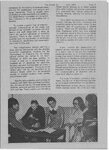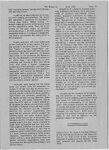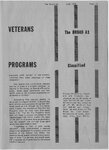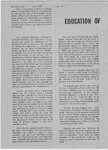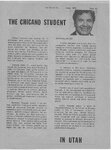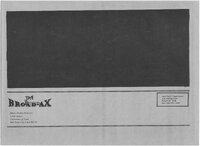| OCR Text |
Show The Broad Ax June 1975 Page 19 One of the greatest concerns of Chicano parents is that their children are not achieving as well as they should in the public school system. This arouses the question of whether equal educational opportunity is available to certainly This question children. Chicano cannot be overlooked in terms of ascertaining whether public schools are meeting the needs of Chicanos. DR. CARLOS ESQUEDA, Professor of Ed Administrationat the University of Utah, elaborated about the education of the Chicano in Utah. He points out that in terms of educational attainment to illustrate the problem, one can make the following statements regarding education for the Chicano: (1) Chicano students in the public schools are below the average of the national norm in educational attainment based on achievement tests; (2) The dropout rate approximates 50 percent of the total enrollment. Chicanos comprise 3 percent of the total schoo! population, however, the dropout rate is 7 percent; (3) Chicanos are grossly underrepresented in teaching positions at all levels. Statistics reveal that approximately 257 or 2 percent of the state’s total number of teachers are Spanish surnamed: (4) Chicano students are isolated by school districts and by schools within school districts; and (5) The language and culture of Chicano children have been ignored and even suppressed by the public schools. Among the many other disadvantages which face the Chicano student, Esqueda mentions that until this current school year, 1974-75, all instruction in the public schools was monolingual. Even though Title VII funds were available under the ESEA since 1969, none of the districts applied for federal assistance. The first bilingual-bicultural program was developed by Chicanos in the five urban school districts (Salt Lake, Granite, Tooele, Jordan and Ogden) during the fiscal year 1974-75. Esqueda asserts that with this basic information, one can readily understand why the educational system is not meeting the needs of Chicano students in the public schools of Utah. EDUCATION OF On the effects of federal aid from Wash- ington, Esqueda notes that this aid tends to reinforce the status quo and has only very rarely resulted in school reform. Title 1 has appropriated millions of dollars to upgrade the education of Chicanos since its inception in 1965, but tragically, the results are not very. encouraging. Our pupils still maintain a lower level of productivity, operating two or three levels below the achievement of their counterparts. He adds that federal Anglo monies have been allocated to public school entities ‘‘“who are doing more of the wrong things or doing the wrong things better.” In conclusion, Esqueda states that the future is certainly quite bleak for Chicano students in the state school system. There is a necessity for meaningful educational change if the education of Chicano children is to improve in the next decade. He suggests that the first step must be the total re-evaluation of the curriculum. The curriculum offerings must be relevant to the experience of the Chicano. culture and Secondly, diagnostic, prescriptive and individualized instruction programs need to be expanded in the state. The immediate implementation of a bilingual-bicultural education program for Chicanos is a must. Thirdly, Esqueda suggests that. a widespread study and revision of school practices-grade iretention ability grouping, assignment to enrichment classes, pushout and dropout causes and assignment of children to mentally defidicnt classes--must be implemented. The elimination of diagnostic testing as a basis for placement is stongly urged. With the new weighted pupil formula in the state, this situation has been somewhat in mind, needs to keep One remedied. Esqueda also adds that ‘Mexicans do poorly in school and society because they are however, they are prevalent minds of Utah. that the more equitable formula went into effect during fiscal year 1973-74 so that irreparable damage was already done to a large number of Chicano school clients. obviously inferior. They are inferior because Mexican.’’ This myth, he states, in the Southwest, exists in the many educators in the State of |




